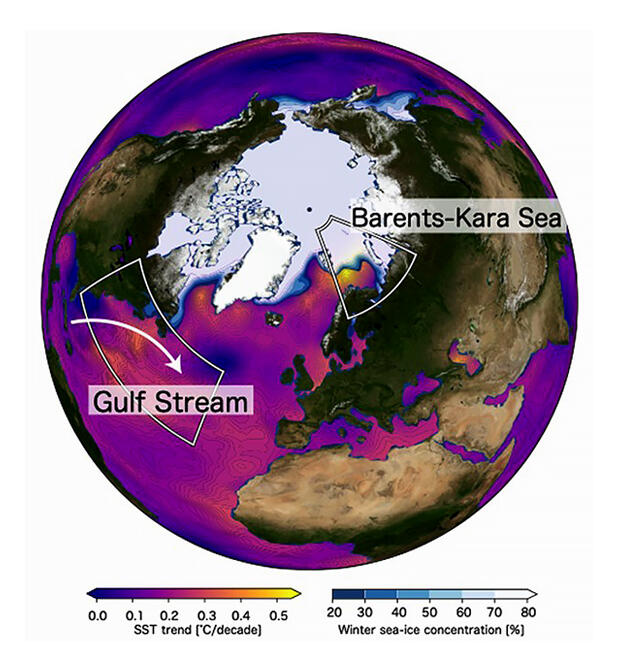A research group led by post-doctoral researcher Yoko Yamagami of the Research Center for Environmental Modeling and Application (CEMA), Japan Agency for Marine-Earth Science and Technology (JAMSTEC), Professor Masahiro Watanabe of the Atmosphere and Ocean Research Institute, the University of Tokyo, Assistant Professor Masato Mori of the Research Institute for Applied Mechanics, Kyushu University, and project researcher Jun Ono of the Institute of Arctic Climate and Environment Research, JAMSTEC, conducted and analyzed climate simulations that reproduced past conditions in the Arctic and found that variability in the sea surface temperatures of the Gulf Stream region is responsible for the reduction in winter sea-ice in the Barents-Kara Sea.

Provided by JAMSTEC
The Barents-Kara Sea, located on the Atlantic side of the Arctic Ocean, has experienced a noticeable decrease in winter sea ice concentration (SIC). Such environmental changes in the Arctic Ocean are believed to affect extreme weather events in the mid-latitudes of the Northern Hemisphere, including Japan. Meanwhile, the rate of winter sea-ice decline in the Barents-Kara Sea has generally been underestimated, even in the latest simulations (CMIP6), but the factors contributing to this rate remain unclear.
The research group compared sea surface temperature in the Gulf of Mexico basin and long-term sea ice concentration in the Barents-Kara Sea (the percentage of sea surface covered by ice) using the results of a simulation of past climate reproduced by the MIROC6 climate model (HIST experiment) and a simulation of variations in sea surface temperature in the Gulf of Mexico basin corrected for observed data (NAGA experiment).
They found that over the period from 1970 to 2017, both long-term changes in sea surface temperature (0.17°C/decade) and sea ice concentration (-2.8%/decade) in the HIST experiment were smaller than observed. The NAGA experiment also showed values comparable to observations. This means that the effect of modified sea surface temperature fluctuations in the Gulf Stream region is manifested in sea ice in the Barents-Kara Sea, more than 4,000 kilometers away.
Based on these results, in comparing atmospheric and oceanic changes around the Barents-Kara Sea between the two simulations to identify the mechanism that causes the difference in sea ice loss rate, they found that heat transfer to the Barents Sea by ocean currents was more pronounced in the NAGA experiment and that surface water temperature increased and sea ice decreased faster in the Barents-Kara Sea than in the HIST experiment. The NAGA experiment also showed a faster temperature rise in the air above Barents-Kara Sea, but this was due to increased heat release from the ocean to the atmosphere as sea ice decreased.
These results indicate that enhanced heat transport associated with changes in ocean currents is responsible for the rapid loss of sea ice in the Barents-Kara Sea. "Studies suggest that long-term changes in surface water temperatures in the Gulf Stream region are key to improving climate change predictions for the Arctic region," explains Yoko Yamagami. "Therefore, we would like to further improve the accuracy of our climate simulations, including the development of high-resolution simulations that can more accurately represent surface water temperature fluctuations in the Gulf Stream region."
This article has been translated by JST with permission from The Science News Ltd.(https://sci-news.co.jp/). Unauthorized reproduction of the article and photographs is prohibited.




